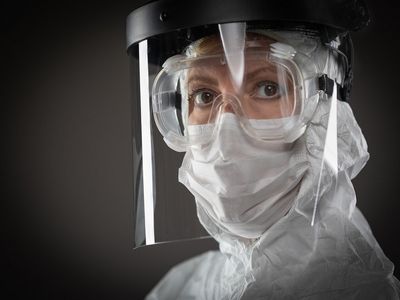Australian Study Reveals That Eye Protection Is Essential In Curtailing SARS-CoV-2 Transmission
Source: Medical News-SARS-CoV-2 Transmission Nov 19, 2021 4 years, 1 month, 2 weeks, 2 days, 10 hours, 28 minutes ago
SARS-CoV-2-Transmission: A new study by researchers from Bond University-Australia that also involved scientists from the Australian National University-Canberra has found that eye protection is also essential in curtailing SARS-CoV-2 transmission!

The study team screened 898 articles and included 6 reports of 5 observational studies from 4 countries (USA, India, Columbia, and United Kingdom) that tested face shields, goggles, and wraparound eyewear on 7567 healthcare workers.
The three before-and-after and one retrospective cohort studies showed statistically significant and substantial reductions in SARS-CoV-2 infections favoring eye protection with odds ratios ranging from 0.04 to 0.6, corresponding to relative risk reductions of 96% to 40%.
These reductions were not explained by changes in the community rates.
However, the one case–control study reported odds ratio favoring no eye protection (OR 1.7, 95% CI 0.99, 3.0). The high heterogeneity between studies precluded any meaningful meta-analysis. None of the studies adjusted for potential confounders such as other protective behaviors, thus increasing the risk of bias, and decreasing the certainty of evidence to very low.
The study findings suggest that eye protection may play a role in prevention of SARS-CoV-2 infection in healthcare workers. However, robust comparative trials are needed to clearly determine effectiveness of eye protections and wearability issues in both healthcare and general populations.
The study findings were published in the peer reviewed journal: Antimicrobial Resistance & Infection Control.
https://aricjournal.biomedcentral.com/articles/10.1186/s13756-021-01025-3
To date, the use of eye protection to reduce the transmission of the SARS-CoV-2 coronavirus is debatable.
The WHO or World Health Organization recommends eye protection like goggles or face shields to health care workers caring for coronavirus disease 2019 (COVID-19) patients. However, no such recommendation exists for those caring for COVID-19 patients at home, even when they live in the same room.
However, in the day to day life, the impact of eye protection on the control of SARS-CoV-2 infection is uncertain.
The
SARS-CoV-2 Transmission study team from Australia recently conducted a systematic review of all available research studies on the impact of eye protection on the transmission of SARS-CoV-2. Criteria for extensive search including screening and data extraction.
The study team conducted an extensive meta-analysis on data procured between January 1, 2020, and June 1, 2021, from the PROSPERO, Embase, PubMed, and Europe PMC preprints databases, as well as the Cochrane Library for clinical studies. Additionally, the WHO International Clinical Trials Registry Platform (ICTRP) and ClinicalTrials.gov databases were also searched through June 1, 2021.
The stringent criteria adopted by the authors for this systematic review were as follows: participants comprised commu
nity or health care workers; interventions included any eye protection such as face shields, goggles, or modified snorkel masks; comparators had no eye protection, with or without face masks; and the outcome was the number of lab-confirmed SARS-CoV-2 infection.
All comparative studies, including before-and-after, were included, except those that did not provide sufficient data for comparison between with and without eye protection, laboratory experiments, and other eye equipment that was not meant for the prevention of respiratory viral transmission.
The data were screened based on titles, abstracts, and full texts, as well as the risk of bias evaluated using the ROBINS-I for observational studies. The confounding factors identified for most of the studies included variation in risk of COVID-19 from before, during, and after the intervention, test frequency, comparator, and settings.
The study team screened 898 articles and included five published observational studies in six reports from four countries in the quantitative analysis.
All these five studies were conducted on healthcare workers who used eye protection ranging from wrap-around eyewear and goggles to full-face shields or visors in addition to approved masks and other infection preventive measures in the corresponding clinical setting.
Interestingly, the three before-and-after studies and one retrospective cohort study presented a statistically significant and considerable decrease in SARS-CoV-2 infections which favors eye protection with odds ratios ranging from 0.04 to 0.6, corresponding to risk reductions of 96% to 40%.
However, in one case-control study, the reported odds ratio did not favor any eye protection, which might be due to an increase in community transmission.
It was noted that any significant meta-analysis was excluded due to the high heterogeneity between studies. Since none of the studies were adjusted for prospective confounders, the risk of bias increased and the certainty of the evidence decreased.
Corresponding author Dr Oyungerel Byambasuren from the Institute for Evidence-Based Healthcare- Bond University told Thailand
Medical News, “These studies provide suggestive evidence that face shields provide some protective effect, and that this may be substantial.”
A past study that reviewed observational studies on the impact of eye protection on SARS-CoV-1 and the Middle East respiratory syndrome (MERS) epidemics showed a decrease in transmission of 66% and 76%, respectively. https://www.sciencedirect.com/science/article/pii/S0140673620311429
Importantly this outcome is comparable with the reductions seen in the three before-after studies of this review.
Yet another past study on mannikins also proved that face shields provide greater protection than masks. Since these studies did not include viral particles, the simulations of human interactions were incomplete.
https://www.tandfonline.com/doi/full/10.1080/15459624.2020.1854459
Though these studies showed potential protection from face shields as an add-on to face masks, they did not clarify whether the protection is from reduced inhalation or eye protection.
This present systematic review suggests that transmission of SARS-CoV-2 in healthcare workers may be reduced by using eye protection. However, further studies are needed to assess the effect of face shields that are used instead of or as add-ons to face masks, as well as to compare eye goggles and face shields with face masks.
For the latest research on
SARS-CoV-2 Transmission, keep on logging to Thailand Medical News.
